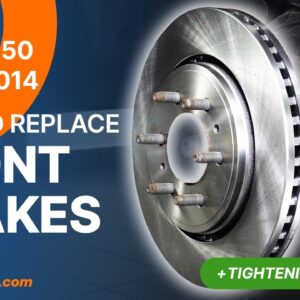Watch this video to learn how to replace the radiator on a 2009-2014 Ford F-150.
Replacing Radiator on a 2009-2014 Ford F-150: What You Need
Ready to perform this DIY replacement job? Remember that all the parts in this guide can be found on CarParts.com. Check out all the products that fit your vehicle right here.
Parts Checklist
- Radiator
- Coolant
- Penetrating oil
Tightening Torques
There are no tightening torques for this operation.
Tools Checklist
Here’s the toolbox we recommend to repair your Ford F-150: HM85 85 Piece Ratchet and Socket Set
List of tools:
- Fluid collector
- Plastic tube
- Flat head screwdriver
- Adjustable pliers
- 10mm wrench
- Fork
- Ratchet
- Extender
- 11mm socket
- 8mm socket
- Phillips screwdriver
- 13mm socket
Step-by-Step Instructions
Step 1: Initial Preparations
- Turn off the engine and engage the parking brake.
- Open the hood using the hood release handle.
- For safety, disconnect the battery.
Step 2: Fluid Collection Preparation
- Prepare a fluid collection container to catch coolant that will flow out.
Step 3: Accessing Radiator Components
- Locate the radiator’s bleed screw beneath the vehicle on the passenger side.
- Attach a plastic tube to the bleed port and connect it to the collection container.
- Unscrew the bleed screw to allow coolant to flow out.
- Open the cap of the coolant expansion tank to facilitate coolant flow.
Step 4: Removing Air Intake Duct
- Remove the breather from the air intake duct by pushing the green tab and pulling it out.
- Unscrew the two clamps on the duct using a flat head screwdriver then remove the duct.
Step 5: Removing Coolant Hose and Fuse Box
- Compress the retaining ring of the coolant hose connected to the radiator using adjustable pliers then remove the hose.
- Unscrew the four screws holding the fuse box using a 10mm wrench then remove the fuse box.
Step 6: Removing Fan Assembly
- Use a fork to remove the retaining clip from the electrical harness on the fan.
- Unclip the air conditioning fluid hose from the radiator using a flat head screwdriver.
- Unclip the electrical harness from the power steering fluid reservoir retaining screw using a fork. Then, Unscrew the retaining screw of the power steering fluid reservoir using a ratchet, extender, and an 11mm socket.
- Remove the power steering reservoir and set it aside.
- Unclip the cooling hose retaining ring using a flat head screwdriver and remove the hose.
- Unclip the harness retaining clip under the fuse box support using a fork.
- Repeat the harness unclipping operation on the fan side, next to the battery.
- Lift the tab securing the passenger-side radiator fan connector using a flat head screwdriver.
- Repeat the operation on the driver’s side.
- Unclip the harness located next to the driver’s side fan.
Step 7: Removing Fan Assembly and Air Duct
- Shift the fuse box assembly to create space to remove the fan assembly.
- Unscrew the two screws holding the fan assembly to the radiator using a ratchet and an 8mm socket then remove the fan assembly.
- Remove the locking clip securing the air duct to the radiator using a flat head screwdriver then remove the air duct.
Step 8: Removing Radiator Components
- Remove the radiator cap and overflow hose.
- Unscrew the plastic rivet from the rubber cover next to the headlights using a Phillips screwdriver.
- Remove the rubber cover and the two clips.
- Access the upper hose on the driver’s side and remove it using adjustable pliers.
- Place a collection container under the lower hose and remove it, allowing coolant to flow out.
- Spray penetrating oil on the two radiator retaining screws.
- Unscrew the radiator retaining screws using a ratchet and a 13mm socket on the engine side.
Step 9: Removing Air Conditioning Radiator and Radiator
- Unclip the air conditioning radiator from the radiator by pulling on the plastic tabs on either side.
- Lift the air conditioning radiator to remove its lugs from the retaining brackets. Then, lift the air conditioning radiator in front to clip the lugs onto the new radiator’s brackets.
- Reclip the upper tabs on the new radiator then place the radiator assembly in its final position by inserting the rubber insulators into their slots. Tighten the two radiator screws.
Step 10: Reattaching Hoses and Covers
- Reattach the hoses on the driver’s side using adjustable pliers.
- Replace the rubber covers next to the headlights and secure them with clips.
- Clip the air duct and lock it in place.
- Slide the fan assembly onto the radiator and tighten the retaining screws.
- Replace the fuse box assembly on its support and reclip harnesses then reconnect the fan power connectors.
Step 11: Reconnecting Radiator Components
- Reattach the cooling hose to its housing and connect it to the radiator using adjustable pliers.
- Clip the air conditioning fluid hose.
- Replace and retighten the power steering fluid reservoir.
- Reclip the harness on the reservoir’s retaining screw.
Step 12: Final Steps
- Tighten the four screws of the fuse box assembly.
- Reinstall the airbox-expansion tank assembly and secure it with screws.
- Reconnect the overflow hose.
- Put the radiator cap back on the new radiator.
- Reconnect the battery.
- Replace the air intake duct and tighten clamps.
- Replace the breather.
Step 13: Refilling and Finalizing
- Refill the radiator with coolant and purge air from the circuit.
- Recheck all connections and components.
Compatible Vehicles
The operation and tools displayed in the video should be available on the following vehicles:
Important Reminders
Get a fluid collection container to collect the coolant that will flow out.
To facilitate the flow of coolant, open the cap of the coolant expansion tank.
Disclaimer:
This video is for entertainment purposes only. Carparts.com, Inc. disclaims all damages including, but not limited to, actual, consequential, and/or punitive, for any liability, claim, or any other injury or cause related to or arising from any information or lack thereof posted in this video. No information contained in this video shall create any expressed or implied warranty or guarantee of any particular result. All mechanical car projects entail some risk. It is the sole responsibility of the viewer to assume this risk. If you are in doubt, please consult a licensed mechanic in your area.
Any information provided on this Website is for informational purposes only and is not intended to replace consultation with a professional mechanic. The accuracy and timeliness of the information may change from the time of publication.
















